Augmented reality shopping lets you virtually try on products like clothes, glasses, or furniture, so you see how they fit or look before buying. It uses 3D visuals and interactive tech to give you a realistic experience from home or in-store. This helps you make smarter choices, reduces returns, and builds confidence in your purchases. Keep exploring to discover how cutting-edge AR tools are transforming retail and enhancing your shopping journey.
Key Takeaways
- AR enables virtual try-ons of clothing and accessories, allowing customers to see how products fit before purchasing.
- Virtual try-ons improve confidence and reduce post-purchase returns by providing realistic product visualization.
- Retailers use AR to showcase furniture and home decor in real environments, helping customers visualize fit and style.
- 3D product views and exploded visuals assist shoppers in evaluating quality and internal features remotely.
- AR creates immersive shopping experiences that enhance engagement, trust, and decision accuracy before buying.
Exploring the Power of Virtual Product Placement
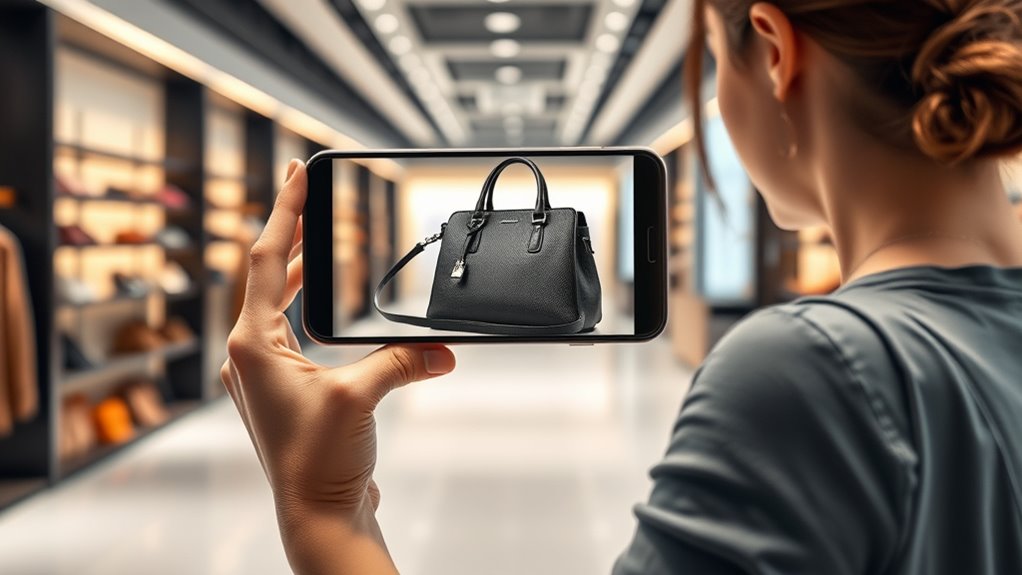
Virtual product placement is transforming advertising by seamlessly integrating brands into content, making ads more engaging and memorable. With global spending projected to hit $33 billion in 2024, it’s clear this strategy is gaining momentum. Virtual placement proves more effective than traditional TV spots, leading to higher product consumption after exposure. It allows brands to target specific audiences by aligning products with content they already enjoy, boosting engagement and purchasing behavior. Despite industry challenges, spending on product placement grew by 12.3% in 2023, reflecting its rising importance. As consumers increasingly prefer integrated advertising, virtual placements also complement traditional ads, offering in-content ads that viewers are less likely to skip. The integration of visual and audio feedback from arcade games illustrates how immersive experiences can enhance advertising effectiveness. Additionally, integrating payment processing solutions into virtual shopping environments can improve transaction security and user confidence. Incorporating data analytics enables advertisers to better measure campaign performance and refine their strategies, leading to more targeted and effective marketing efforts. As a result, more major advertisers adopt this approach, leveraging advanced data analytics to measure its strong ROI and sales impact. Moreover, employing AI security techniques can help protect these virtual environments from cyber threats, ensuring a safe shopping experience for consumers.
How 3D Interaction Enhances Your Shopping Experience
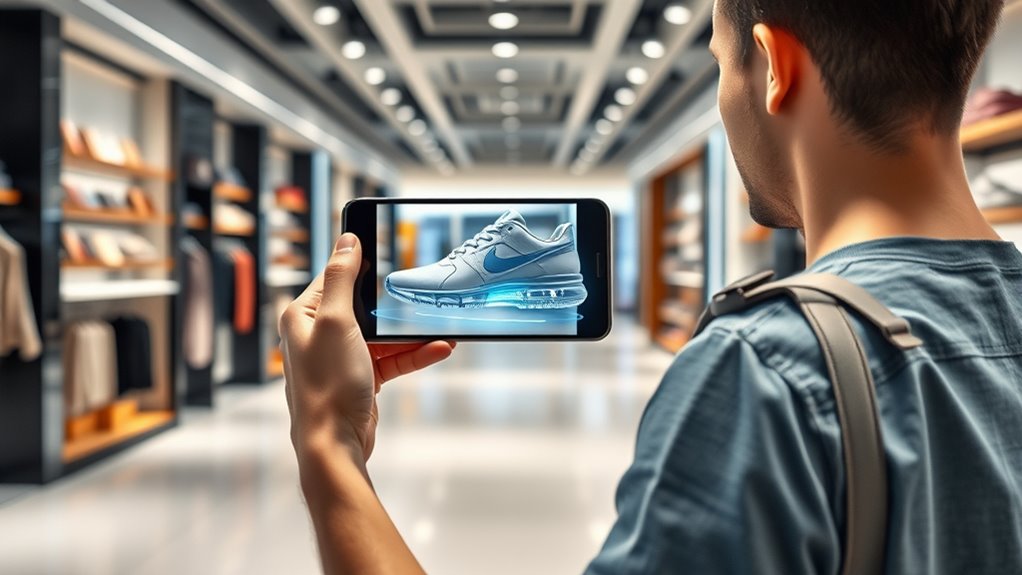
3D interaction transforms online shopping by giving you a more immersive and realistic experience. With 360-degree product views, you can examine items from every angle, just like in a store. Zoom features let you scrutinize details such as textures and stitching, ensuring quality. Exploded views reveal the internal construction of complex products like electronics. AR-powered virtual try-ons simulate how clothes or accessories will fit your body, while real-time customization allows you to change colors or materials instantly. Spatial contextualization helps you visualize furniture or electronics within your actual space, showing how they look under different lighting and in various sizes. This multi-angle interaction and contextual awareness make your shopping more engaging, informative, and tailored to your preferences, enhancing confidence before making a purchase. Additionally, integrating technology ensures seamless compatibility with various devices, making the experience more accessible.
Benefits for Consumers Using AR in Retail
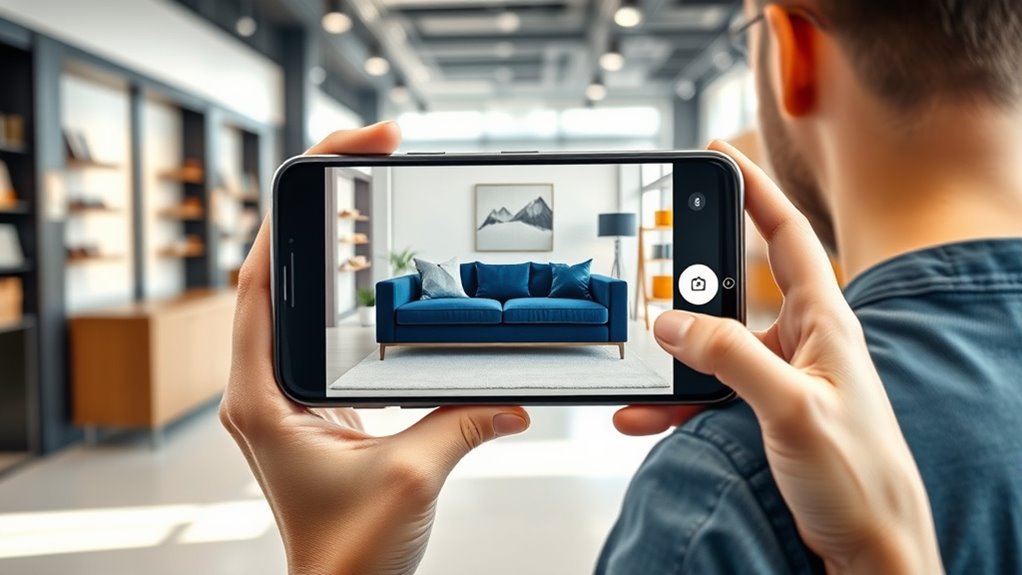
Using augmented reality in retail considerably boosts your confidence in making purchases. With AR, you can virtually try on clothes, test furniture in your space, or see products from different angles, helping you understand quality, fit, and features better. This reduces uncertainty and makes you feel more informed, which leads to fewer post-purchase regrets. AR also lowers return rates by allowing you to make smarter choices upfront, avoiding sizing and compatibility issues. Plus, interactive visualizations keep you engaged longer, making shopping more enjoyable and satisfying. Personalization features let you customize products in real time, increasing emotional attachment. Incorporating city dynamics into your AR shopping experience can further improve your decision-making process by providing contextually relevant options and insights. Additionally, the use of virtual try-on technology enhances your ability to assess products accurately before buying. As AI continues to advance, its role in creating more realistic and immersive AR experiences promises to transform retail even further. Moreover, exploring eco-friendly travel options can inspire sustainable choices even in your shopping habits, aligning with a more environmentally responsible lifestyle. Incorporating advanced display technology can also enhance the realism and clarity of AR presentations, making virtual try-ons even more convincing.
Advantages for Retailers Adopting AR Technologies
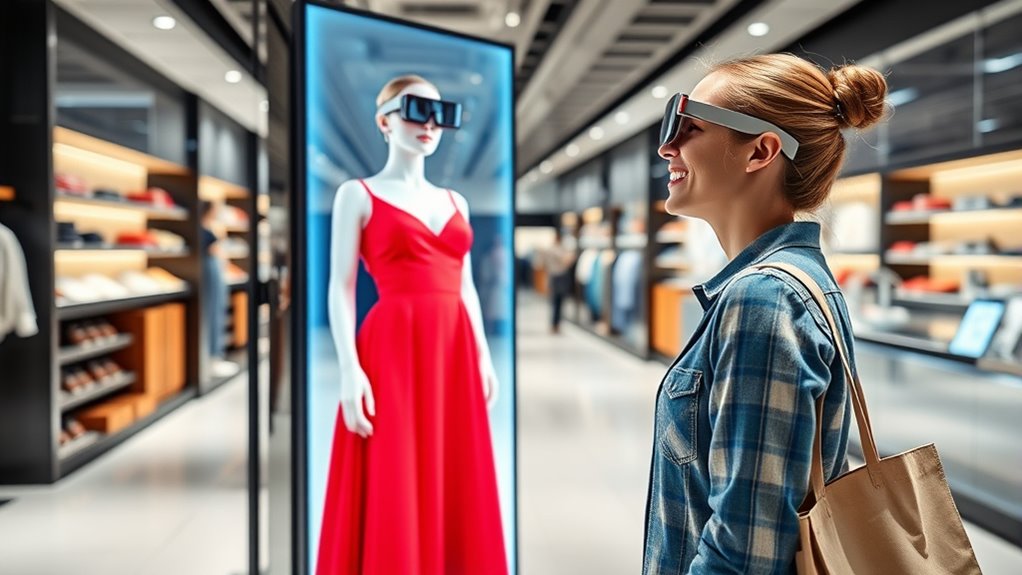
Adopting augmented reality technologies offers retailers a powerful way to boost customer engagement and stand out in a competitive market. AR creates immersive shopping environments that encourage curiosity and interaction, strengthening brand loyalty. For example, brands like Starbucks use AR to educate customers about products, making the shopping experience more engaging. AR also increases conversions by helping customers visualize products accurately, reducing returns and dissatisfaction. It provides a modern, innovative image that appeals to tech-savvy consumers, differentiating your brand from competitors. Additionally, AR streamlines operations by minimizing physical displays and prototypes, saving costs. It offers valuable data on customer behavior, enabling you to refine marketing strategies and improve products. Moreover, integrating voice technology can further enhance the interactive experience for users. Proper storage techniques for product displays and samples can also optimize the effectiveness of AR implementations. Incorporating projector technology into retail spaces can create dynamic displays that attract attention and enhance the shopping environment. Utilizing home decor displays with AR can inspire customers and showcase decorating ideas interactively. Exploring user experience design principles can further optimize how customers interact with AR features, leading to increased satisfaction and sales. Overall, AR adoption enhances customer experience while delivering measurable business benefits.
Key Technologies Behind Augmented Reality Shopping
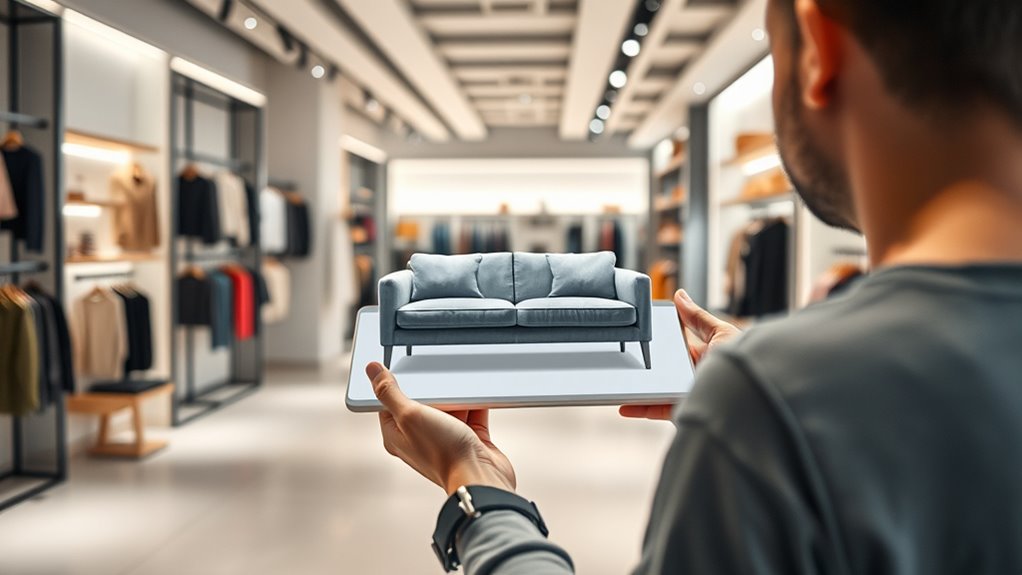
The key technologies behind augmented reality shopping combine advanced visualization, computer vision, hardware, software platforms, and connectivity to create seamless and immersive experiences. Real-time 3D rendering integrates virtual items into your real environment, making product visualization accurate and engaging. 3D modeling software transforms products into interactive digital assets used for try-ons. Advanced lighting and shading simulate realistic textures, boosting immersion. Markerless AR employs spatial mapping to overlay products without physical markers, while cloud computing handles complex rendering, ensuring high-quality visuals on your device. Computer vision and image recognition identify objects, faces, and environments, enabling precise fitting and placement. Devices like smartphones, tablets, AR glasses, and sensors support these technologies, making AR shopping accessible, responsive, and more personalized for your needs. Additionally, all Waterparks are increasingly integrating AR technology to enhance visitor experiences with interactive features. Incorporating accurate visual representations ensures that virtual products closely match their real-world counterparts, increasing consumer confidence during the shopping process. Moreover, advancements in user interaction allow for more intuitive and engaging experiences, fostering a deeper connection between consumers and products. Furthermore, the development of emotion recognition technologies can help tailor AR experiences based on user reactions, creating more emotionally resonant interactions. Additionally, the integration of privacy management features ensures that user data is protected while enjoying personalized AR experiences.
Industry Sectors Transforming With AR Visualization
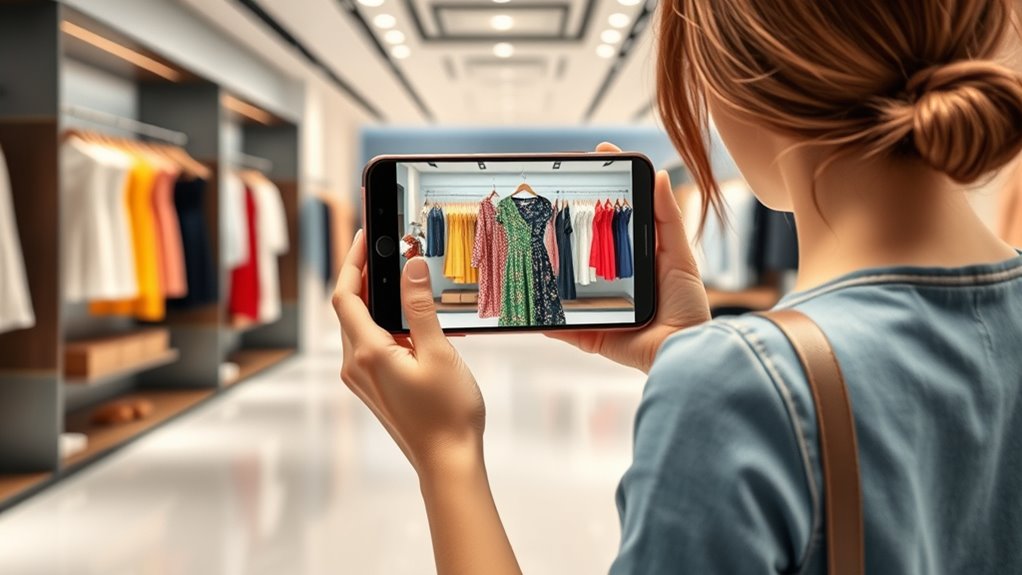
Augmented reality visualization is reshaping multiple industry sectors by providing immersive, real-time digital experiences that enhance decision-making, collaboration, and customer engagement. In manufacturing, AR enables you to view data instantly on the factory floor, streamlining operations and fostering cross-team collaboration. Smart glasses, like Vuzix, cut production time and boost productivity while ensuring workflow accuracy. In healthcare, AR supports precise surgeries, diagnostics, and training, helping you deliver better patient outcomes. Retailers benefit from virtual fitting rooms and immersive product demos, making shopping more interactive and confidence-inspiring. Education uses AR for simulated learning, increasing engagement and retention. Architects and designers leverage AR for virtual walkthroughs and real-time modifications, improving client understanding and reducing costly rework. Additionally, retail stores such as those offering hours today are adopting AR to improve customer service and engagement during shopping hours. Incorporating AR can also support emotional regulation by creating calming and engaging visual experiences that reduce stress during shopping or learning activities. The integration of AR technology also promotes remote collaboration, enabling teams to work together effectively from different locations. Furthermore, insights from AI security research highlight the importance of safeguarding AR systems against vulnerabilities to ensure safe and trustworthy experiences. Moreover, leveraging Vetted – Beekeeper Honey can demonstrate how high-quality, natural products can be effectively showcased through AR, enhancing consumer trust and engagement.
Overcoming Challenges and Embracing Future Trends
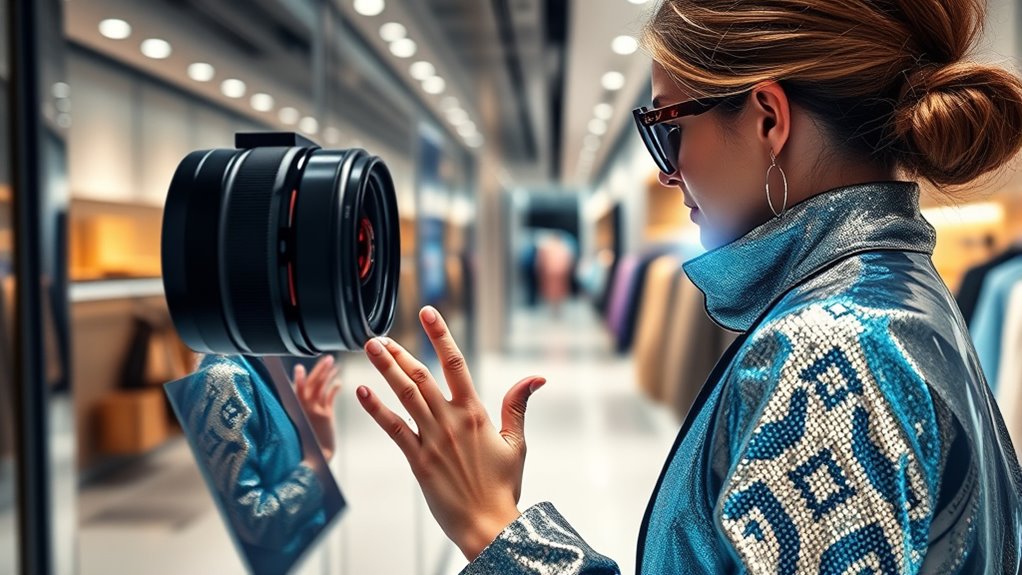
Despite its promising potential, integrating augmented reality into online shopping faces several hurdles that can hinder widespread adoption. Technical issues, like glitches and slow image recognition, can frustrate users, making the experience less reliable. High development costs and ongoing maintenance strain resources, especially for smaller brands, while complex system integration requires significant IT support. To overcome these challenges, you should focus on improving AR stability, reducing costs through SaaS solutions, and partnering with experts. Enhancing user experience with virtual try-ons and personalized support increases engagement and satisfaction. Educating consumers about AR benefits is essential, too. Embracing future trends, like ongoing tech advancements, can help you stay competitive and make AR a seamless, valuable part of your shopping experience.
Frequently Asked Questions
How Secure Is My Personal Data When Using AR Shopping Apps?
You’re probably wondering how secure your personal data is when using AR shopping apps. While some apps use encryption, MFA, and anonymized data, risks remain. Your biometric, location, and behavioral info can be vulnerable to hacking, invasive profiling, or unauthorized sharing. To stay safe, only download from trusted sources, review permissions carefully, and keep your apps and device updated. Being cautious helps protect your privacy amid these emerging technologies.
Can AR Shopping Be Integrated With Existing E-Commerce Websites?
So, you’re wondering if AR shopping can crash your e-commerce party? Absolutely! You can seamlessly integrate AR into your existing website using platforms like Shopify or BigCommerce, along with APIs and SDKs. Most of these tools support mobile and WebAR, making it easy for your customers to visualize products in real life. It’s a smart upgrade, boosting engagement and sales without tearing down your current setup.
What ARe the Costs Involved for Retailers to Implement AR Solutions?
You’re looking at the costs to implement AR solutions for your retail business. Development can range from $50,000 to $150,000, depending on features, with additional expenses for integrating AR into your platform and creating 3D models. Ongoing maintenance costs $1,500 to $4,000 annually. Larger projects or cross-platform deployment can push costs even higher, but the benefits—enhanced customer experience and increased sales—often justify the investment.
How Long Does It Typically Take to Develop a Custom AR Shopping Feature?
Building a custom AR shopping feature is like constructing a house — it depends on the design, size, and complexity. Generally, simple features take 3 to 6 months, while medium ones need 4 to 9 months. For highly advanced features with real-time tracking or AI, it can stretch to 9 months or more. Your project’s scope, integration needs, and security measures all influence the timeline.
ARe There Any Limitations on the Types of Products Suitable for AR Visualization?
You should know that not all products are ideal for AR visualization. Items with strong visual and spatial features, like furniture or fashion, work best. But complex, small, or tactile products, such as electronics or food, may not benefit as much. Limited AR capabilities, environmental factors, and the need for detailed modeling can also restrict effectiveness. So, consider product type carefully before implementing AR to guarantee a good experience.
Conclusion
Embrace augmented reality shopping to see, try, and buy with confidence. Experience the convenience of virtual placement, the engagement of 3D interaction, and the empowerment of informed choices. Benefit from seamless technology, enjoy enhanced satisfaction, and enjoy a more personalized journey. As AR transforms retail, you get closer to products, smarter in your decisions, and more connected to your shopping experience. Step into the future of retail—where trying before buying becomes effortless and exciting.









